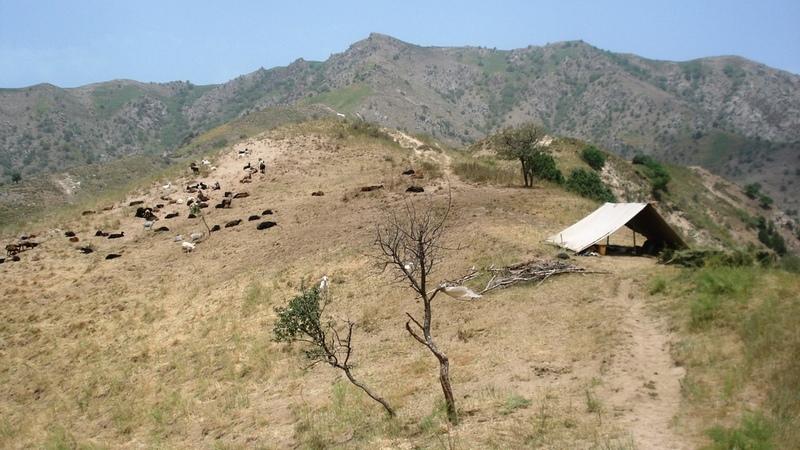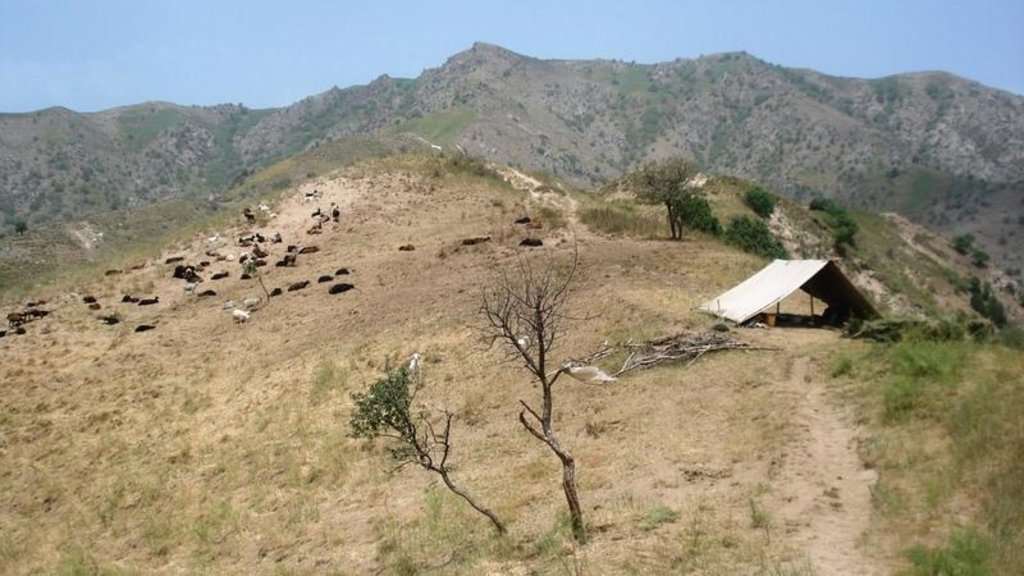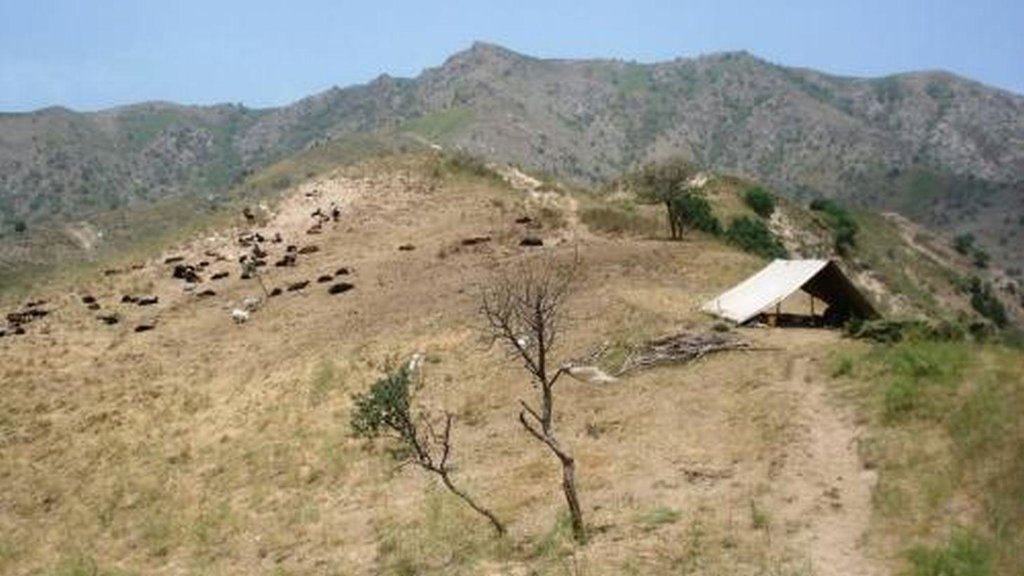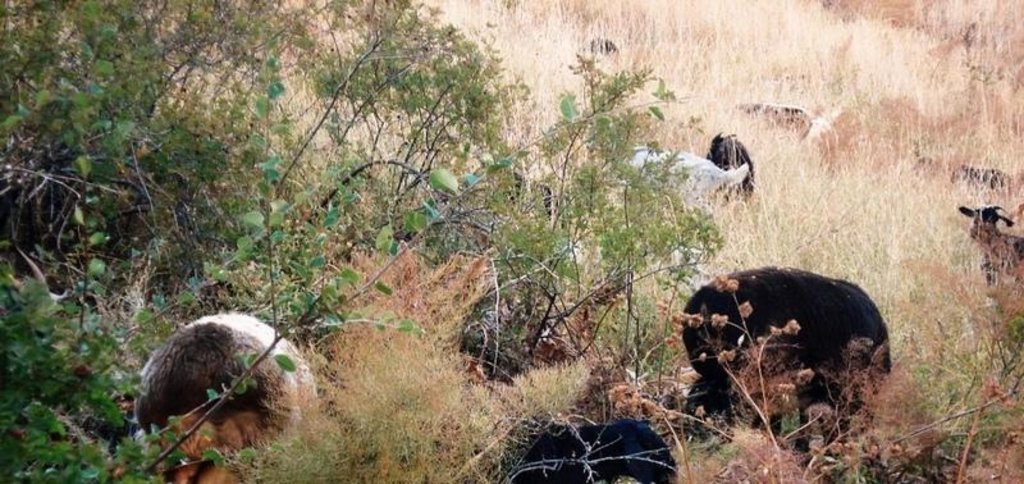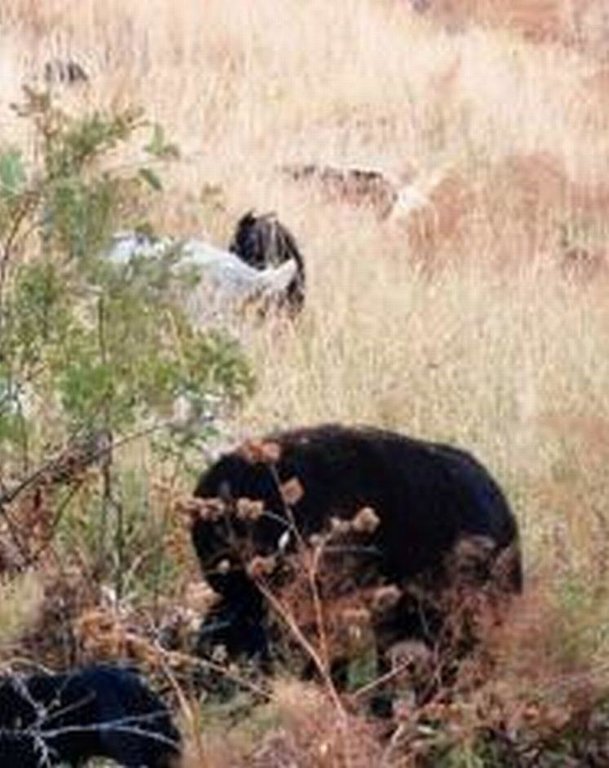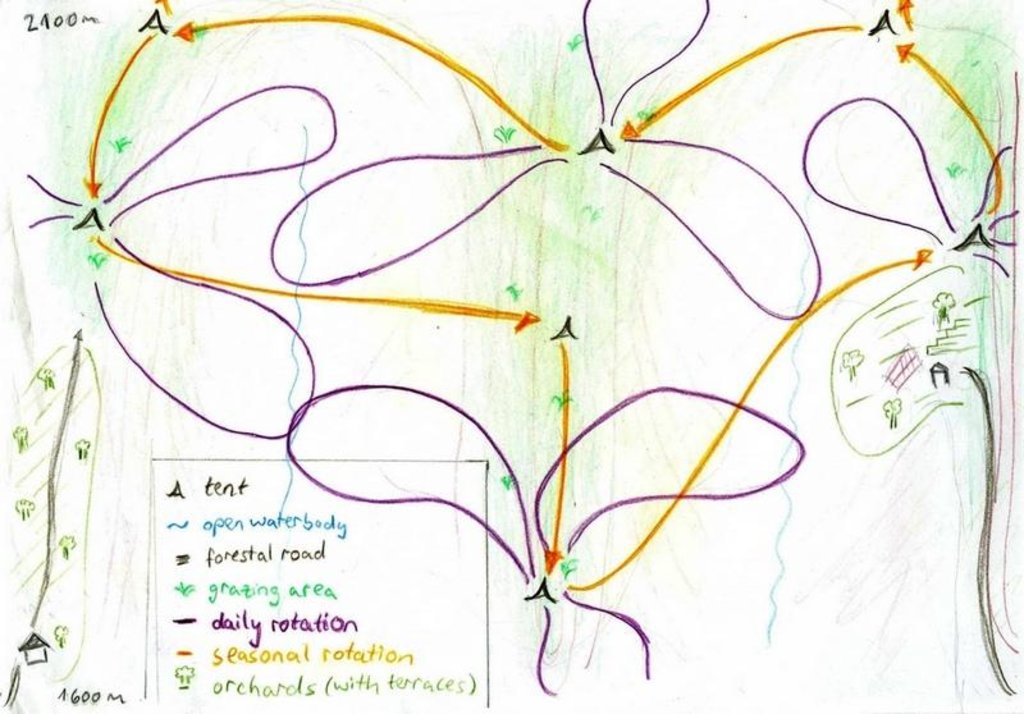Daily and seasonal rotation on grassland [طاجيكستان]
- تاريخ الإنشاء:
- تحديث:
- جامع المعلومات: Christian Wirz
- المحرر: –
- المراجعون: David Streiff, Alexandra Gavilano
Dajmardei Kaspi (professional herder)
technologies_1407 - طاجيكستان
عرض الأقسام
توسيع الكل طي الكل1. معلومات عامة
1.2 تفاصيل الاتصال بالأشخاص الرئيسيين لمصدر المعلومات والمؤسسات المشاركة في تقييم وتوثيق التقنية
اسم المؤسسة (المؤسسات) التي سهلت توثيق/تقييم التقنية (إذا كان ذلك على صلة)
CDE Centre for Development and Environment (CDE Centre for Development and Environment) - سويسرااسم المؤسسة (المؤسسات) التي سهلت توثيق/تقييم التقنية (إذا كان ذلك على صلة)
NCCR North-South (NCCR North-South) - قرغيزستان1.3 الشروط المتعلقة باستخدام البيانات الموثقة من خلال WOCAT
يوافق جامع المعلومات والشخص (لاشخاص) الرئيسي لمصدر المعلومات على الشروط المتعلقة باستخدام البيانات الموثقة من خلال WOCAT:
نعم
1.5 الإشارة إلى الاستبيان (الاستبيانات) حول مناهج الإدارة المستدامة للأراضي (موثقة باستخدام WOCAT)
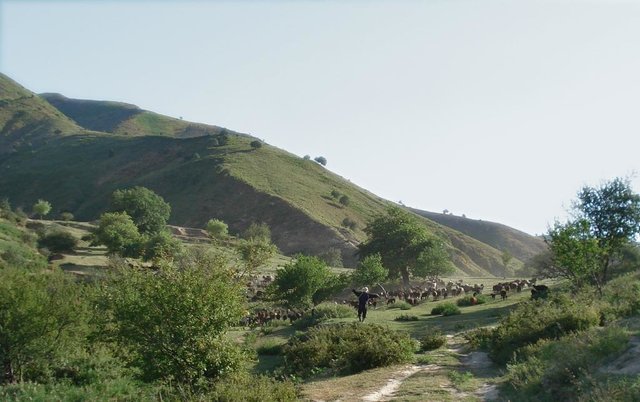
Seminomadic individual herding [طاجيكستان]
Pasture management by a single herder, assisted either by an employee or by his own grandchildren, in collaboration with the habitants of the nearby village Karsang.
- جامع المعلومات: Christian Wirz
2. وصف تقنيةالإدارة المستدامي للأراضي
2.1 وصف مختصر للتقنية
تعريف التقنية:
Extensive grazing of sheep and goats by the means of a precise rotational scheme
2.2 وصف تفصيلي للتقنية
الوصف:
Half-year herding with 500 sheep, goats and cows (very few), with 7-8 different locations of the herder's tent. The herder visits each place twice to thrice per grazing season and stays in one place for one week to maximally one month (during the Ramadan period, due to limited forces). The area is grazed from the higher zone (around 2000m) to the lower zone (around 1600m) twice per season, in a sort of circle. Every day the herder starts in another direction from his tent and leads the animals to the pastures, once in the morning and once in the evening. He passes a stream once (autumn) to twice (summer) a day.
Purpose of the Technology: The grass should not get dusty and dirty, explaining why the herder daily changes the pastures, only revisiting the same places every two to three days.
Establishment / maintenance activities and inputs: After accompanying his father as a child and a kind of an apprenticeship (of one year) later on, M. is considered by the villagers as a good herder and they give him their animals for herding. But M. applies for land on the forest department only after working as a guardian and as a tractor driver for 20 years. For the herding profession observing the animals precisely is necessary, in order not to lose any of them. And the maintenance of the pastures is guaranteed by the strict rotational scheme.
Natural / human environment: The pasture-area is in a generally well-conserved state. Moderate to high values of fractional vegetation cover can be observed and only few signs of recent erosion processes (through water) are visible. The area is characterised by steep slopes where still signs of past tree-planting during the USSR period are visible by some trees, many little platforms made for tree-planting and a few terraced areas. Eventhough, many trees have been grazed and do not stand anymore. Besides steep areas there are small, quite flat areas (where the herder installs his tents), that used to be cultivated (wheat) till 1966. These areas generally have low cover-values and signs of rill-erosion, which the herder attributes to the past tilling activity. However, it might also be the trampling and sitting of the animals (staying near the herder's tent at noon-time and during the night) causing this erosion. Nutrient management is provided for by the dung of the animals which is not collected, contrarily to the pastures near the villages.
2.3 صور التقنية
2.5 البلد/المنطقة/المواقع التي تم تنفيذ التقنية فيها والتي يغطيها هذا التقييم
البلد:
طاجيكستان
المنطقة/الولاية/المحافظة:
Region of Republican Subordination
مزيد من التفاصيل حول الموقع:
Faizabad
التعليقات:
Total area covered by the SLM Technology is 3 km2.
The half of the herded area is rented by another person from the village, who gives his animals to the herder. Apart from the interviewed herder there are varying numbers of other semi-nomadic herders with similar management practices, some of them from other regions.
Map
×2.6 تاريخ التنفيذ
في حالة عدم معرفة السنة بالتحديد، يرجى الإشارة إلى التاريخ التقريبي:
- منذ أكثر من 50 عامًا (تقليدي)
2.7 إدخال التقنية
حدد كيف تم إدخال التقنية:
- كجزء من النظام التقليدي (> 50 عامًا)
التعليقات (نوع المشروع، الخ):
There are traditional herding peoples like Kuagwates, Kaleks, Lakais, Duramanes, Kurtshaliks), not Tajiks. These often move around with their whole families.
3. تصنيف تقنية الإدارة المستدامي للأراضي
3.2 نوع (أنواع) استخدام الأراضي الحالية حيث يتم تطبيق التقنية

أراضي الرعي
الرعي الواسع النطاق:
- رعي شبه مرتحل
نوع الحيوان:
- الماعز
- الأغنام
- cows
الصنف:
الماعز
العدد:
500
الصنف:
الأغنام
العدد:
500
التعليقات:
Livestock density (if relevant):
< 1 LU/km2
Major land use problems (compiler’s opinion): The trampling of the animals near the tent, the feeding on young trees and the daily passage of the herd of a limited number of streams (eutrophication).
Major land use problems (land users’ perception): No major land use problems due to good management. Only the first rain that cannot be absorbed by the dry soils is a problem.
Semi-nomadism / pastoralism: sheep* / goats* / cows
Future (final) land use (after implementation of SLM Technology): Grazing land: Ge: Extensive grazing land
3.4 إمدادات المياه
إمدادات المياه للأرض التي يتم تنفيذ التقنية عليها:
- بعلية
التعليقات:
Specify:
Longest growing period in days: 270Longest growing period from month to month: Oct - Jun
3.5 مجموعةالإدارة المستدامة للأراضي التي تنتمي إليها هذه التقنية
- الرعي وإدارة المراعي
3.6 التدابير التقنية في مجال إلادارة المستدامة للأراضي

التدابير الإدارية
- M1: التغيير في نوع استخدام الأراضي
- M4: تغيير كبير في توقيت الأنشطة
التعليقات:
Main measures: management measures
3.7 الأنواع الرئيسية من تدهور الأراضي التي تناولتها التقنية

التدهور الكيميائي للتربة
- (Cn): تراجع الخصوبة وانخفاض محتوى المادة العضوية (غير ناتج عن الانجراف)

التدهور البيولوجي
- (Bs): انخفاض جودة وتركيبة الأنواع/التنوع
التعليقات:
Secondary types of degradation addressed: Cn: fertility decline and reduced organic matter content, Bs: quality and species composition /diversity decline
Main causes of degradation: overgrazing (Causing Pc, Bc, Wt), droughts (Causing Pk, Pc, Ha), degradation of near-village pastures (The pressure on more distant areas increases)
Secondary causes of degradation: soil management (passed tilling with impact on Wt), floods (Intensive rains causing Wt), land tenure (Little interest in tree-planting if land can only be rented annually)
3.8 منع أو حد أو عكس تدهور الأراضي
تحديد هدف التقنية فيما يتعلق بتدهور الأراضي:
- منع تدهور الأراضي
التعليقات:
Main goals: prevention of land degradation
4. المواصفات الفنية، وأنشطة التنفيذ، والمدخلات، والتكاليف
4.1 الرسم الفني للتقنية
المواصفات الفنية (المتعلقة بالرسم الفني):
Daily and seasonal rotation.
Location: Above Karsang. Faizabad / Tajikistan
Date: 05.08.09
Technical knowledge required for field staff / advisors: low (Obeying to what the herder says)
Technical knowledge required for land users: moderate (It is necessary to know how to lead animals, more than in the case of the common pasture-area)
Main technical functions: control of dispersed runoff: retain / trap, increase of biomass (quantity)
Secondary technical functions: improvement of ground cover, control of fires, palatable fodder
Change of land use type: From afforestation and limited use as cropland to extensive grazing
Major change in timing of activities: Introduction of a strict rotational grazing scheme
المؤلف:
Christian Wirz, Switzerland
4.2 معلومات عامة بخصوص حساب المدخلات والتكاليف
حدد العملة المستخدمة لحساب التكاليف:
- دولار أمريكي USD
اذكر متوسط تكلفة أجر العمالة المستأجرة في اليوم الواحد:
6.10
4.3 أنشطة التأسيس
| النشاط | التوقيت (الموسم) | |
|---|---|---|
| 1. | Buying a herd | constantly investing |
4.4 التكاليف والمدخلات اللازمة للتأسيس
| تحديد المدخلات | الوحدة | الكمية | التكاليف لكل وحدة | إجمالي التكاليف لكل مدخل | % من التكاليف التي يتحملها مستخدمو الأراضي | |
|---|---|---|---|---|---|---|
| غير ذلك | Buying a herd | animals | 50,0 | 87,7 | 4385,0 | 100,0 |
| إجمالي تكاليف إنشاء التقنية | 4385,0 | |||||
| إجمالي تكاليف إنشاء التقنية بالدولار الأمريكي | 4385,0 | |||||
التعليقات:
Duration of establishment phase: 12 month(s)
4.5 الصيانة/الأنشطة المتكررة
| النشاط | التوقيت/الوتيرة | |
|---|---|---|
| 1. | Rent fee for land of forest department | once per year |
| 2. | Salary of an assistant herder (normally, but not in 2008) | at the end of the season |
| 3. | compensation for dead animals | at the end of the season |
| 4. | Animal medecine | if necessary |
| 5. | Salt | daily |
4.6 التكاليف والمدخلات اللازمة للصيانة/للأنشطة المتكررة (سنويًا)
| تحديد المدخلات | الوحدة | الكمية | التكاليف لكل وحدة | إجمالي التكاليف لكل مدخل | % من التكاليف التي يتحملها مستخدمو الأراضي | |
|---|---|---|---|---|---|---|
| العمالة | Salary of an assistant herder | Days | 120,0 | 6,1 | 732,0 | 100,0 |
| غير ذلك | Rent fee for land of forest department | 300ha/d | 180,0 | 0,4888888 | 88,0 | 100,0 |
| غير ذلك | Compensation for dead animals | animals | 2,0 | 44,0 | 88,0 | 100,0 |
| غير ذلك | Animal medecine | per year | 1,0 | 88,0 | 88,0 | 100,0 |
| غير ذلك | Salt | kg | 1000,0 | 0,08 | 80,0 | 100,0 |
| إجمالي تكاليف صيانة التقنية | 1076,0 | |||||
| إجمالي تكاليف صيانة التقنية بالدولار الأمريكي | 1076,0 | |||||
التعليقات:
The costs are valid for a herd of 250 animals kept by the herder alone for six months and additional 250 animals kept during summer holidays with the help of additional workforce. The salary indicated was not valid for 2008 (the grandsons helped the herder), but for years when M. hires external workforce. For all costs, including 50 own animal, prices in 2008 are taken.
4.7 أهم العوامل المؤثرة على التكاليف
قدم وصفا لأهم العوامل التي تؤثر على التكاليف:
Buying an own herd and looking for the animals are the most expensive factors, expecially if there are sick or dead animals.
5. البيئة الطبيعية والبشرية
5.1 المناخ
هطول الأمطار السنوي
- < 250 مم
- 251- 500 ملم
- 501 - 750ملم
- 1,000-751 ملم
- 1,500-1,100 ملم
- 2,000-1,500 ملم
- 3,000-2,001 ملم
- 4,000-3,100 ملم
- > 4000 ملم
المواصفات/التعليقات على هطول الأمطار:
Mainly in spring and also in autumn, with a trend to decrease
المنطقة المناخية الزراعية
- شبه قاحلة
Thermal climate class: temperate
5.2 طوبوغرافيا
متوسط الانحدارات:
- مسطح (0-2%)
- بسيط (3-5%)
- معتدل (6-10%)
- متدحرج (11-15%)
- تلال (16-30%)
- شديدة الانحدار(31-60%)
- فائقة الانحدار (>60%)
التضاريس:
- هضاب/سهول
- أثلام مرتفعة
- المنحدرات الجبلية
- منحدرات التلال
- منحدرات في السفوح
- قاع الوادي
المنطقة الارتفاعية:
- 100-0 متر فوق سطح البحر
- 500-101 متر فوق سطح البحر
- 1,000-501 متر فوق سطح البحر
- 1,500-1,001 متر فوق سطح البحر
- 2,000-1,501 متر فوق سطح البحر
- 2,500-2,100 متر فوق سطح البحر
- 3,000-2,501 متر فوق سطح البحر
- 4,000-3,001 متر فوق سطح البحر
- > 4000 متر فوق سطح البحر
التعليقات والمواصفات الإضافية بشأن التضاريس:
Altitudinal zone: Pasture area around 1600 to 2000 m
Landforms ridges: Small, not so steep areas where the tent of the herder is installed
Landforms mountain slopes: The pasture area is generally very steep
Slopes on average steep (31-60%): The areas mostly frequented are steep
Slopes on average very steep (>60%): The areas dominating spatially are very steep
Slopes on average hilly (16-30%): Ridge areas
5.3 التربة
متوسط عمق التربة:
- ضحل جدًا (0-20 سم)
- ضحلة (21-50 سم)
- متوسطة العمق (51-80 سم)
- عميقة (81-120 سم)
- عميقة جدًا (> 120 سم)
قوام التربة (التربة السطحية):
- متوسط ( طميي، سلتي)
المواد العضوية في التربة السطحية:
- منخفضة (<1%)
إذا كان متاحًا، قم بإرفاق وصف كامل للتربة أو تحديد المعلومات المتوفرة، على سبيل المثال نوع التربة، الرقم الهيدروجيني/ درجة حموضة التربة، قدرة التبادل الكاتيوني، النيتروجين، الملوحة وما إلى ذلك.
Soil depth on average shallow: Most grassy areas
Soil fertility is low: on the surface of 300 ha the summed up dung of 500 sheep and goats cannot compensate for the loss of topsoil by wind and water
Soil drainage / infiltration is good: Generally high infiltration capacity enhanced by high vegetation cover values
Soil water storage capacity medium (dominatig the area): Loamy soils and high cover values, but generally little trees and dried vegetation in August
Soil water storage capacity can also be good: Near the streams higher water retention, according to herder
5.4 توافر المياه ونوعيتها
توافر المياه السطحية:
ضعيف/ غير متوافر
نوعية المياه (غير المعالجة):
للاستخدام الزراعي فقط (الري)
تعليقات ومواصفات أخرى بشأن نوعية المياه وكميتها:
Water quality (untreated): Locals drink the water, but are affected by diarrhoea
5.5 التنوع البيولوجي
تنوع الأنواع:
- مرتفع
التعليقات والمواصفات الإضافية بشأن التنوع البيولوجي:
Diversity higher than near the villages, but not comparable with biodiversity hot-spots
5.6 خصائص مستخدمي الأراضي الذين يطبقون التقنية
مستقر أو مرتحل:
- شبه مرتحل
الدخل من خارج المزرعة:
- أقل من % 10من كامل الدخل
المستوى النسبي للثروة:
- ثري
أفراداً أو مجموعات:
- فرد/أسرة معيشية
الجنس:
- رجال
اذكر الخصائص الأخرى ذات الصلة لمستخدمي الأراضي:
Land users applying the Technology are mainly common / average land users
Difference in the involvement of women and men: Herding is considered as a male profession, inherited from father to son. In nomadic peoples the whole families are mobile and women are responsible for domestic work.
Population density: < 10 persons/km2
Annual population growth: 1% - 2%
100% of the land users are rich (100).
Off-farm income specification: The herder claims to nourish himself and his wife with the income from herding. But, once he willl not be able to work as a herder anymore, he might depend on off-farm income from his children (remittances)
5.7 متوسط مساحة الأرض التي يستخدمها مستخدمو الأراضي الذين يطبقون التقنية
- < 0.5 هكتارا
- 0.5 - 1 هكتار
- 1 -2 هكتار
- 2 - 5 هكتار
- 5 - 15 هكتار
- 15 - 50 هكتار
- 50 - 100هكتار
- 500-100 هكتار
- 1,000-500 هكتار
- 10,000-1,000 هكتار
- > 10,000 هكتار
هل يعتبر هذا نطاقًا صغيرًا أو متوسطًا أو واسعا (في إشارة إلى السياق المحلي)؟:
- على نطاق صغير
التعليقات:
3 households can afford to pay the services of the professional herder (clearly a minority of village population)
5.8 ملكية الأراضي، وحقوق استخدام الأراضي، وحقوق استخدام المياه
ملكية الارض:
- دولة
حقوق استخدام الأراضي:
- مؤجر
حقوق استخدام المياه:
- مجتمعي (منظم)
5.9 الوصول إلى الخدمات والبنية التحتية
الصحة:
- ضعيف
- معتدل
- جيد
التعليم:
- ضعيف
- معتدل
- جيد
المساعدة التقنية:
- ضعيف
- معتدل
- جيد
العمل (على سبيل المثال خارج المزرعة):
- ضعيف
- معتدل
- جيد
الأسواق:
- ضعيف
- معتدل
- جيد
الطاقة:
- ضعيف
- معتدل
- جيد
الطرق والنقل:
- ضعيف
- معتدل
- جيد
مياه الشرب وخدمات الصرف الصحي:
- ضعيف
- معتدل
- جيد
الخدمات المالية:
- ضعيف
- معتدل
- جيد
6. الآثار والتصريحات الختامية
6.1 الآثار التي أظهرتها التقنية في الموقع
الآثار الاجتماعية والاقتصادية
الإنتاج
إنتاج الأعلاف
التعليقات/ حدد:
Higher vegetation cover and biomass values than for village-pastures
جودة العلف
التعليقات/ حدد:
Much less impalatable species' frequency
إنتاج حيواني
التعليقات/ حدد:
The animals get much fatter and are sold for around 50% higher price than animals from common pastures
إنتاج الخشب
التعليقات/ حدد:
The herder says that tree density has decreased, due to livestock but also to chopping. Additionally chopping of living trees is generally forbidden (since the 1960s, when the forest department was created as a new land use type), not making possible the
منطقة الإنتاج
التعليقات/ حدد:
The use of the land for fruit production is not possible with animals grazing, but this was also the case before, as to the herder's opinion
توافر المياه ونوعيتها
نوعية مياه الري
التعليقات/ حدد:
Due to reduced stocking rates in comparison with village-pastures (and the soviet times), better water quality
الآثار الاجتماعية والثقافية
الأمن الغذائي / الاكتفاء الذاتي
الوضع الصحي
الفرص الترفيهية
Livelihoods and human well-being
الآثار الايكولوجية
دورة المياه / الجريان السطحي
الجريان السطحي
التعليقات/ حدد:
Better control of runoff, but steeper land
تصريف المياه الزائدة
التربة
غطاء التربة
الكمية قبل الإدارة المستدامة للأراضي:
40%
الكمية بعد الإدارة المستدامة للأراضي:
80%
التعليقات/ حدد:
Higher cover than on village-pastures
التنوع البيولوجي: الغطاء النباتي، الحيوانات
التنوع النباتي
الكمية قبل الإدارة المستدامة للأراضي:
36 species
الكمية بعد الإدارة المستدامة للأراضي:
47 species
التعليقات/ حدد:
More plant systematical diversity
الحد من مخاطر المناخ والكوارث
خطر الحريق
التعليقات/ حدد:
According to forest department the area above Karsang, due to ist trees, is more prone to fires than other areas
6.3 تعرض التقنية وحساسيتها لتغير المناخ التدريجي والظواهر المتطرفة/الكوارث المرتبطة بالمناخ (كما يراها مستخدمو الأراضي)
الظواهر المتطرفة / الكوارث المرتبطة بالمناخ
الكوارث المناخية
| كيف تتعامل التقنية مع ذلك؟ | |
|---|---|
| جفاف | ليس جيدا |
العواقب الأخرى المتعلقة بالمناخ
العواقب الأخرى المتعلقة بالمناخ
| كيف تتعامل التقنية مع ذلك؟ | |
|---|---|
| انخفاض فترة النمو | جيدا |
التعليقات:
A possible adaption to dryer conditions would be smaller herds.
6.4 تحليل التكلفة والعائد
كيف يمكن مقارنة العوائد نسبة لتكاليف الإنشاء (من وجهة نظر مستخدمي الأراضي)؟
عوائد قصيرة الأجل:
محايد/متوازن
عوائد طويلة الأجل:
ايجابي جدا
كيف تتم مقارنة العوائدمع كلفة الصيانة/التكاليف المتكررة (من وجهة نظر مستخدمي الأراضي)؟
عوائد قصيرة الأجل:
إيجابي قليلا
عوائد طويلة الأجل:
إيجابي
التعليقات:
4 Years ago a herd of 400 animals had to be sold due to disease. Since then M was able to rebuild a herd of 500 animals. On a short term investing into animals is expensive but pays quickly. The maintenance costs are finally decisive, but quite constant.
6.5 اعتماد التقنية
- حالات فردية/تجريبية
إذا كان متاحًا، قم بتحديد الكمية (عدد الأسر المعيشية و/أو المساحةالمغطاة):
1 Household
من بين جميع الذين تبنوا التقنية، كم عدد الذين فعلوا ذلك بشكل تلقائي، أي دون تلقي أي حوافز مادية/مدفوعات؟:
- 10-0%
التعليقات:
100% of land user families have adopted the Technology with external material support
1 land user families have adopted the Technology with external material support
Comments on acceptance with external material support: The herder gets paid by the villagers for taking care of their animals
There is no trend towards spontaneous adoption of the Technology
Comments on adoption trend: According to the herder, young people do not (want to) bear the very physical work.
6.7 نقاط القوة / المزايا / الفرص التي توفرها التقنية
| نقاط القوة/ المزايا/ الفرص من وجهة نظر مستخدمي الأراضي |
|---|
|
Grazing stabilises the soils and is thus a prevention against gully erosion in areas with low cover (former cropland). Animals have the same effect as the terraces built years ago. How can they be sustained / enhanced? Grazing activity should continue, once M. is too old for working. |
| The animals provide for soil fertility by their dung, instead of the fertilisers used in Soviet times. This positively influences the share of palatable plants and cover in general and, by this, soil moisture. |
| The area on the forest department is a good alternative to the much too small pasture-area near the village |
| نقاط القوة/ المزايا/ الفرص من وجهة نظر جامع المعلومات أو غيره من الاشخاص الرئيسيين لمصدر المعلومات |
|---|
|
Form of land use making it possible to take some pressure from the common pastures without great damages. How can they be sustained / enhanced? It needs to be assured that also poorer families, who depend even more on livestock breeding than richer ones, can give their animals to M. or other professional herders. This could be realised by engaging herder assistants from poor families |
|
The rotational scheme is much more elaborated than in the case of the villages' pastures, which can be explained by more land available How can they be sustained / enhanced? Land users like M. should be addressed by forest administration to elaborate legal forms of herding with little damages on natural resources on this land. This will probably require land reforms. |
6.8 نقاط ضعف / مساوىء / مخاطر التقنية وسبل التغلب عليها
| نقاط الضعف/ المساوىء/ المخاطر من وجهة نظر مستخدم الأراضي | كيف يمكن التغلب عليها؟ |
|---|---|
| Tree planting is not possible as long as the area is used for grazing. | By giving people land for longer periods (than one year) and with more freedoms in its use, people would gain interest in diversifying use: They would split up "their" land into haymaking, orchard and pasture areas. |
| نقاط الضعف/ المساوىء/ المخاطر من وجهة نظر جامع المعلومات أو غيره من الاشخاص الرئيسيين لمصدر المعلومات | كيف يمكن التغلب عليها؟ |
|---|---|
| The main problem of this form of grazing is that it doesn't allow the regrowth of trees. | Changing the areas use for grazing, respectively haymaking, every few years. |
| Cover is markedly reduced around the places where tents are installed. | By changing the camping place (but: limited flat areas!) or not keeping the animals in the same place at noon time and during night time, these areas might recover. |
7. المراجع والروابط
7.1 طرق جمع/مصادر المعلومات
الروابط والوحدات المواضيعية
توسيع الكل طي الكلالروابط

Seminomadic individual herding [طاجيكستان]
Pasture management by a single herder, assisted either by an employee or by his own grandchildren, in collaboration with the habitants of the nearby village Karsang.
- جامع المعلومات: Christian Wirz
الوحدات المواضيعية
لا يوجد وحدات مواضيعية


